Forget the flash cards... try the FACT BALL app
that brings math and pinball to their fingertips.
|
Have a child that needs to practice their math facts?
Forget the flash cards... try the FACT BALL app that brings math and pinball to their fingertips.
1 Comment
My oldest son spent a bit of time this summer reviewing a few math concepts that he'll need to know for the coming school year. His teachers generously lent us the math book, but I found the books filled with more 'practice problems' than actual explanations and so turned to the web for more resources. Jackpot! Designed by classroom teachers for grades 3 through 12, this fabulous resources offers video tutorials for both Math and Language Arts. The easy to understand videos (which follow a predictable pattern) offered great instruction in the area of probability. I'm eager to explore the other areas as well.
Free of charge and 'deep' with videos, guided practice, and coach commentary, this video jackpot is a well organized and helpful resource for summer practice AND school year learning for students, parents and classroom teachers! Plastic tumblers (full of dice) are the perfect toy to leave near the couch for impromptu math games. Here's a few family favorites: 1) Shake your tumbler and empty your dice on the cushion. 2) Tally the dots on all your dice. 3) The person with the highest sum - wins! This is a great game to support developing addition skills. You can encourage your child to "add up" the dice by placing them in groups of ten. You can also adapt this game to practice odds and evens. I.e...Winner of the round is the person with the most "odd" dice rolled during a turn.
Easy, cheap, and quick - it's a math game fun for all! A recent fun find at the toy store: Don't You FORGET IT! I'm not sure what I love about this game most: 1) It reinforces my 1st grader's developing math skills. 2) It fits in a small, easy-to-carry bag for travel. 3) It involves both strategy and chance. 4) I have yet to win, but know I will ... if I just keep playing! 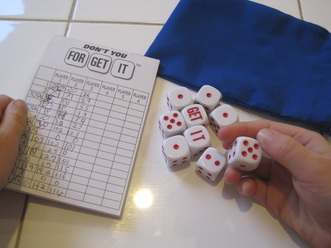 The rules are easy to understand and can be adapted to fit a variety of ages. Players roll, add their dice, and try to avoid the dreaded FOR~GET~IT. Your kids will be adding, carrying, and estimating probability - before you even know it! _ This past summer, I told you we were forming a LEGO Robotics Team. Well.. we were and we did and the results... were fabulous! Our team was made up of seven great kids (both boys and girls) ranging in age from 3rd grade to 6th grade. The team met weekly (September - December) to complete a research project, to build and program a robot to tackle the First Lego League 2011 Food Factor Robot Challenge, and to work together as a team to improve collaboration skills. Typing this now, it all sounds so nice and civilized -- but the reality actually involved a lot more noise, commotion, and chaos in my basement that I had anticipated. Now having survived a Lego Robotic season, I offer these words of warning to anyone considering coaching a Lego Robotics Team in the future: Coaching a team will cause you to learn more about robots and middle school boys than you've ever wanted to know. That said... I admit the combination is worth the chaos. When our team earned the tournament high score - the boys jumped up and down and squealed just like the eight year old girls (maybe even louder). It was incredibly satisfying to see the kids enjoy such a unique opportunity. Now with the season over, my boy is teetering on the edge of STEM student and mad scientist. He's broken down our team robot and reconfigured it to make the 'Alpha Rex. 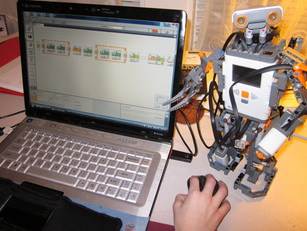 _Each day he programs this robot to attempt something new and I find that I too have been bitten by the robotic-bug because I keep making requests: "Can he give me a high-five?" "I want to see him dance." "Use that light sensor-thingy." "What else can you make him say?" The programming software that comes with the robot set is a little beyond me, but my nine year old keeps trying new configurations of loops, sensors, movement, and switches -- and he continues to have success. The first of tonight's programs aimed to have the robot walk forward until it "sensed" my son's hand waving. Then the robot was to move its arm and continue walking until it received a high-five. At that point, the robot would say "Good Job" and show a skull and crossbones on it's small reader screen. Tomorrow night, I'm told he wants to make a voice controlled car, a catapult that fires on command, or a robot that looks and acts like a crocodile. I'll keep you posted on the results.
Pizza eaters of the world love their pie, and what’s not to love? Bread, cheese, and warm-hand-held goodness. In fact, I’d like to offer this tag line to the pizza chains of America: “Do not underestimate the power of pizza.” How powerful is pizza? It’s powerful enough to serve as its own math curriculum. Enter: Pizza Fractions... This game is a hit at our house. Easy enough for Kinders and just as appropriate for 4th graders, players spin, slice and build their very own pizzas as they make sense of fourths, thirds, and halves.
Food has always been my favorite way to approach this topic with school children – as everyone can relate to sharing food. It’s real life math with a purpose. Here’s a few online games with the same focus: It’s time again for the State Treasurer’s Reading Investment! For this Oregon based program,
K-5 students keep a reading log and earn entry in a drawing to win a $500 Oregon College Saving Plan scholarship. Required reading includes children's books about money, finances, and banking. The deadline is March 18th. Students can submit multiple entries. Happy Reading! Paragraph. This summer our family is embarking on a big trip! I mean a BIG trip! This will be our first ever across-the-Atlantic-my-babies-have-passports-please-oh-please-Mr. Volcano-stop-erupting WOWZA of a BIG trip! (Send your prayers!) In an effort to suppress the “How many days until I ride on an airplane? questions (which have already begun), my youngest son and I spent the afternoon making a paper chain to help us with our vacation countdown. Simple, easy, old fashion fun! For those who need a recap, here are the basics: 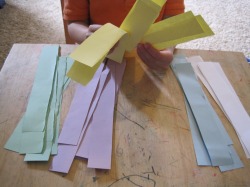 1) Cut your paper strips. You can use construction paper, old magazine pages, or even cut-up paper bags. I used different colors of copy paper.  2) Number each paper strip (Great time for some extra handwriting & number sense practice. Tee hee!). 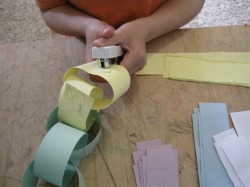 3) Staple the rings together to create your chain. 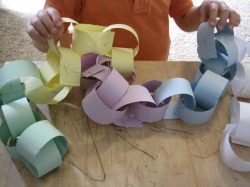 4) Now hang up your creation and take turns tearing off a ring each day until you are down to #1. My son was proud to show the chain to his brother and Dad after dinner and explain the countdown process. This is a great activity for anyone looking forward to a holiday, birthday, or other special event.
It was nice to sit with my son and talk about our upcoming trip while working on this project. It gets me even more excited for the adventure ahead. Now if I can just explain to my husband that we don't begin packing on the day we get down to chain #1, but instead get an early start - we'll be golden! |
At Home
Categories
All
|